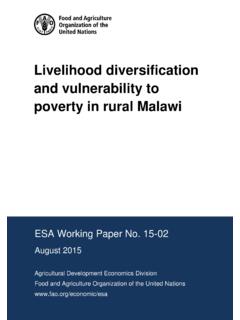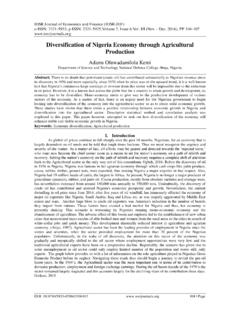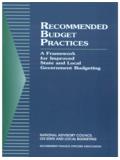Transcription of Traditional fermented food and beverages for …
1 ISSN 1810-0775. r a d i t i o n a l f e r m e nted T. f o o d a n d b e v erages for improved livelihoods )$2 'LYHUVL FDWLRQ ERRNOHW . diversification booklet number 21. r a d i t i o n al fermented T. food and beverages for improved livelihoods Elaine Marshall and Danilo Mejia Rural Infrastructure and Agro-Industries Division food and Agriculture Organization of the United Nations Rome 2011. The designations employed and the presentation of material in this information product do not imply the expression of any opinion whatsoever on the part of the food and Agriculture Organization of the United Nations (FAO) concerning the legal or development status of any country, territory, city or area or of its authorities, or concerning the delimitation of its frontiers or boundaries.
2 The mention of specific companies or products of manufacturers, whether or not these have been patented, does not imply that these have been endorsed or recommended by FAO in preference to others of a similar nature that are not mentioned. The views expressed in this information product are those of the author(s). and do not necessarily reflect the views of FAO. ISBN 978-92-5-107074-1. All rights reserved. FAO encourages reproduction and dissemination of material in this information product. Non-commercial uses will be authorized free of charge, upon request. Reproduction for resale or other commercial purposes, including educational purposes, may incur fees. Applications for permission to reproduce or disseminate FAO copyright materials, and all queries concerning rights and licences, should be addressed by e-mail to or to the Chief, Publishing Policy and Support Branch, Office of Knowledge Exchange, Research and Extension, FAO, Viale delle Terme di Caracalla, 00153 Rome, Italy.
3 FAO 2012. Preface v Table of contents Acknowledgements vii Introduction 1. The origin and rationale of fermentation: Traditions and culture 1. Diversity of fermented products 3. fermented foods 4. Traditional beers and wines 6. Market potential 12. Purpose of the booklet 13. Fermentation and sustainable livelihoods 15. food security and cultural importance 15. Nutritional value 19. Benefits to small-scale farming systems 22. Adding value 23. Employment benefits 23. Financial rewards 25. Gender development 26. Traditional medicinal value 27. Essentials of fermentation 29. What's involved: Key steps in fermented foods and beverages 29. Fermentation skills and techniques 30. Overview of fermented fruits and vegetables from around the world 32. Overview of fermented grains and cereals from around the world 42.
4 Strategies for successful income generation 53. Market appraisal 53. Marketing strategies 55. Organization for the enterprise 60. Summary 61. Support services to promote fermented foods and beverages 63. Public policy 63. Technical training 64. Business skills development 65. Financial services 65. Technology transfer 66. Advisory roles 69. Opportunities and challenges 71. Public policy: Regulations and laws 72. Safety and quality 72. Gender issues 72. People with disabilities 73. Enterprise sustainability 73. Selected further reading 75. Sources of further information and support 79. Table of contents Preface The purpose of the FAO diversification booklets is to raise awareness and Traditional fermented food and beverages for improved livelihoods provide decision support information about opportunities at farm and local community level to increase the incomes of small-scale farmers.
5 Each booklet focuses on a farm or non-farm enterprise that can be integrated into small farms to increase incomes and enhance livelihoods. The enterprises profiled in the FAO diversification booklets selected are suitable for smallholder farmers in terms of resource requirements, additional costs, exposure to risk and complexity. The products or services generated by the enterprises are suitable for meeting demand on a growing, or already strong, local market and are not dependent on an export market. However, in this booklet export markets will be considered, because enterprise development, local markets and prices will be influenced by imports. The main target audience for these booklets are people and organizations that provide advisory, business and technical support services to resource- poor small-scale farmers and local communities in low- and middle-income countries.
6 It is hoped that enough information is given to help these support service providers to consider new income-generating opportunities and how these might enable small-scale farmers to take action. What are the potential benefits? What are farmer requirements and constraints? What are critical success factors'? The diversification booklets are also targeted to policy-makers and programme managers in government and non-governmental organizations. What actions might policy-makers take to create enabling environments for small-scale farmers to diversify into new income-generating activities? The diversification booklets are not intended to be technical how to do it' guidelines. Readers will need to seek more information or technical support, so as to provide farmer advisory and support activities relating to the introduction of new income-generating activities.
7 To assist in this respect, v each booklet identifies additional sources of information, technical support and website addresses. A CD has been prepared with a full series of diversification booklets, relevant FAO technical guidelines, together with complementary guidelines on market research, financing, business planning, etc. Copies of the CD are available on request from FAO. FAO diversification Booklets also can be downloaded from the FAO Internet site. If you find this booklet of value, we would like to hear from you. Tell your colleagues and friends about it. FAO would welcome suggestions about possible changes for enhancing our next edition or regarding relevant topics for other booklets. By sharing your views and ideas with us we can provide better services to you.
8 Vi Acknowledgements Gratitude is owed to Doyle Baker, Senior Technical Officer, Rural Infrastructure Traditional fermented food and beverages for improved livelihoods and Agro-Industries Division, (AGS), FAO, who provided for a detailed technical review on a previous draft version of this booklet. Special thanks also go to Alexandra R ttger, Agribusiness Economist, (AGS), Stepanka Gallatova, Agro-Industry Officer, (AGS), Divine Njie, Senior Officer, (AGS), and Martin Hilmi, Small Enterprise Management and Marketing Consultant, (AGS), for their reviews, inputs and advice on previous drafts of this booklet. Acknowledgements for the series Gratitude is owed to Doyle Baker, Senior Technical Officer, Rural Infrastructure and Agro-Industries Division (AGS), FAO, for his vision, encouragement and constant support in the development of the FAO diversification booklet series.
9 Martin Hilmi managed the development, production and post-production of the series and provided technical support and inputs. Michael Breece undertook the design and layout of the booklets and desktop publishing. vii Introduction fermented products can play an from the heterogeneity of traditions Traditional fermented food and beverages for improved livelihoods important role contributing to found in the world, cultural the livelihoods of rural and peri- preference, different geographical urban dwellers alike, through areas where they are produced and enhanced food security, and income the staple and/or by-products used generation via a valuable small- for fermentation. In many instances scale enterprise option. There is it is highly likely that the methods such a diversity of fermentable of production were unknown and substrate available year round, that came about by chance, and passed the activity can provide a regular down by cultural and Traditional income.
10 Although harvesting values to subsequent generations. or substrate may be seasonal, Some of the most popular fermented fermentation itself is largely products derive from grain, fruit independent of weather, and by- and vegetables and are alcoholic- products can be recycled into based most notably and popularly livestock fodder. a variety of Traditional beers and Fermentation activities are wines. There are also many fermented highly combinable with a variety food products which are extremely of other Traditional and domestic important in meeting the nutritional activities, and can make a requirements of a large proportion of particularly important contribution the global population. Such products to the livelihoods of women, the have a long history of production via disabled and landless poor who, kitchen fermentation, contributing with appropriate training and to household nutrition and to important access to inputs, can increase their socio-cultural practices.

















